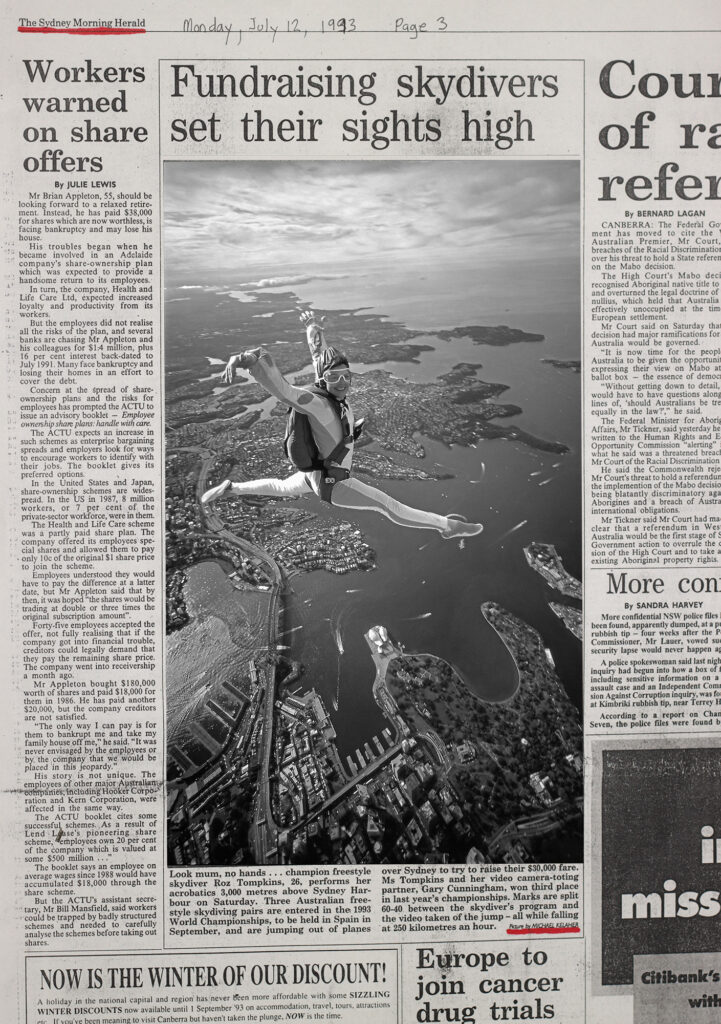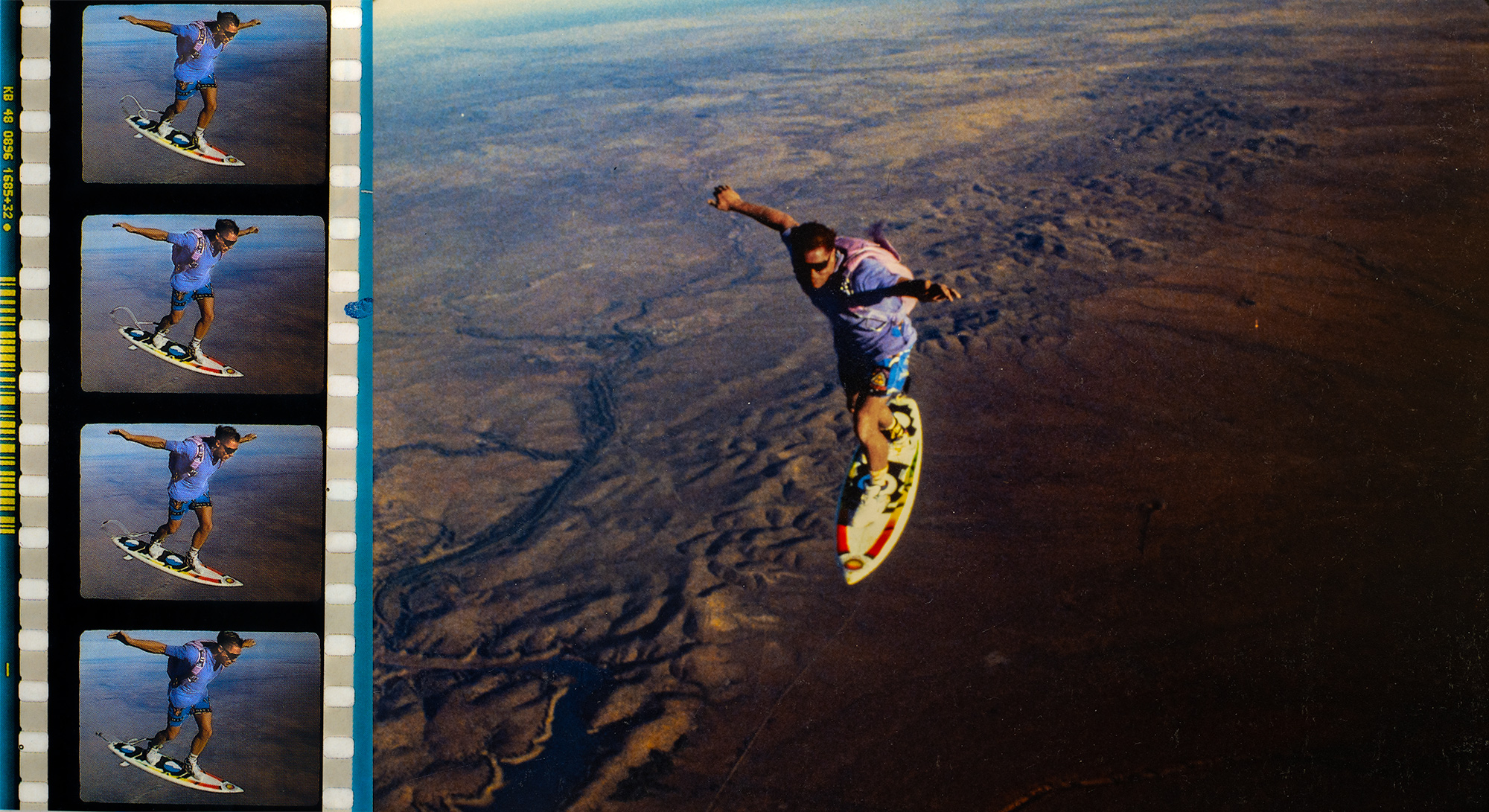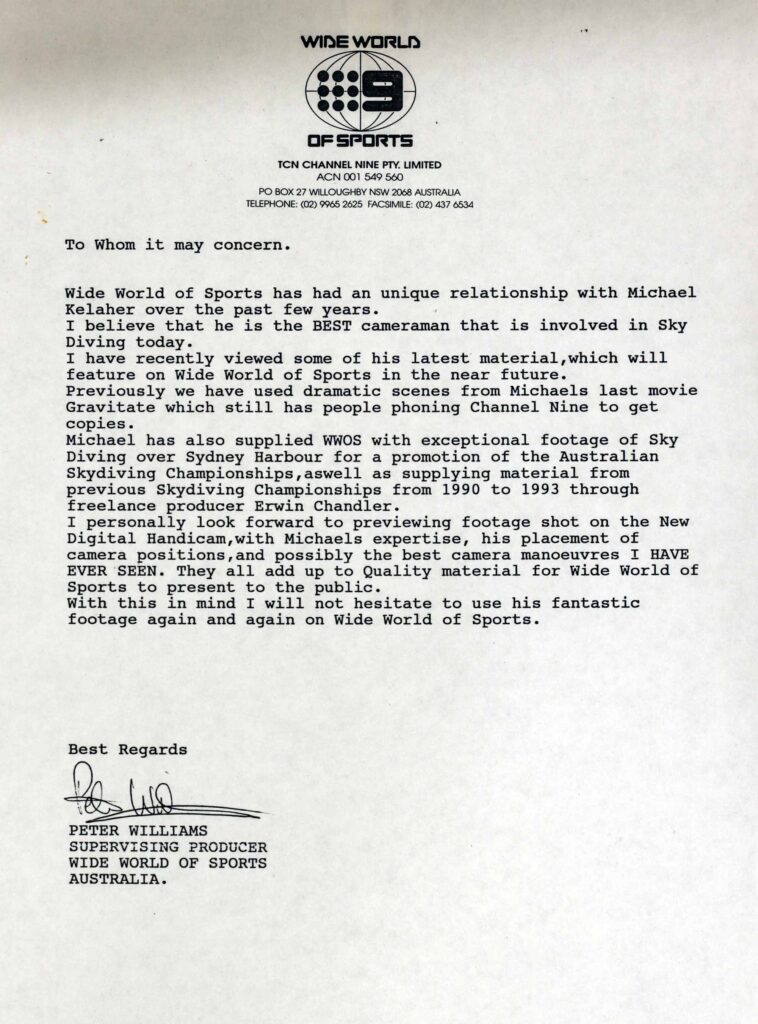
Overview Information
Rare and real – archival prints available for the first time.
Twenty twenty-three marks 30 years since this image was captured, to celebrate this occasion, massive framed archival prints will be produced for the first time.
Rare
There have only ever been four standard, relatively small, 20 inch by 30 inch, chromogenic prints produced of this photograph. In the weeks after the Sydney Harbour skydive in 1993, prints were produced for Roz Tompkins (the subject of the photograph), the Australian Parachute Federation, the skydiving centre and in 1996 one print for the sponsor of our skydiving team.
Real
With the emergence and the world awash with artificial intelligence (AI) generated imagery, an unadulterated photograph of something that actually happened, will be much sought after. A genuine human experience captured that is visually stunning and contains an inspiring symbolic message about people in general and has cultural relevance will always be intuitively preferred. AI is truly amazing and will be of net benefit for society, however with AI still images and graphics the ‘banner blindness’ effect will become common, where instinctually people know something is artificially contrived and ignore it.
Published in the New York Times, world famous image.
The photograph was first published by the Sydney Morning Herald Newspaper in 1993, it was syndicated around the world to numerous publications including the New York Times.
Why is this photograph an emblem of inspiration and optimism?
This photograph serves as a spectacular reminder that people are capable of truly amazing feats, in this case Roz is the first and only person to ever straddle simultaneously the Sydney Harbour Bridge and Sydney Opera House, obviously this takes free-fall skills, poise, body and spatial awareness in order to manage in a weightless free-fly environment of 250 Kph. However it is just a sport after all, about the mind blowing sensations of unencumbered flight, exhilaration, adventure, enjoyment, camaraderie and the challenge.
The important point is that the image is a symbolic cue or reminder about people in general and our capabilities, not just a particular sport, person or photographer.
The challenges humanity currently needs to overcome, such as fighting diseases, stopping poverty and wars also the innovation and technology needed for such things as sustainable energy for example – the photograph is a prompt or stimulus saying– we can do it, if we are prepared to put our minds to work.
The sheer boldness, verve and audacious vibe of the image , is capable of igniting a sense of marvel and optimism.
Tourist boom, promoted the beauty of Australia in a unique way to millions around the world.
At that time, millions of people around the world viewed the photograph in various publications, this promoted the amazing beauty of Sydney Harbour and consequently Australia in a very spectacular and distinguishing way.
Who is that unencumbered human flyer in this world famous photograph.

The late Roz Tompkins: Gravity powered unencumbered flyer extraordinaire.
Roz created a piece of world-famous Sydney harbour photographic history, by being the first and only person to simultaneously straddle the Sydney harbour bridge and Sydney opera house while free flying at 250 Kph. The photo was seen by millions around the world in newspapers and magazines including the New York Times.
Roz had placed third at world championship level multiple times with camera-flyer teammates Gary Cunningham and Craig Field.
Roz was the Australian women’s freestyle skydiving champion on multiple occasions.
Roz was an AFF skydiving instructor, she was there in freefall safely guiding hundreds of people on their first ever skydive.
In Australia Roz was a pioneer in freestyle skydiving and coached fellow skydivers wanting to learn how to perform freestyle manoeuvres safely.
Roz became well-known to the public, a couple of examples, after the Sydney Harbour skydive Roz was interviewed by Ken Sutcliffe on the Wide World of Sports TV show, also she was interviewed by Andrew Denton on his national late night television show.
In 1996 the Australian skydiving championships were held at Corowa, NSW during the Christmas new year period. To keep in shape and for exercise, daily Roz was riding her push-bike from the town of Corowa to the airport. Early one morning, while riding to the airport, Roz was hit by a truck, she was flown to hospital in Melbourne, however Roz died in ICU a few days later.
Roz Tompkins was loved and respected by her contemporaries, her image over Sydney Harbour will continue to inspire and spark future generations.
Cultural significance and the photograph’s composition.
The photograph has cultural significance in terms of aesthetics and history. From the aesthetic perspective while Roz simultaneously straddles globally recognizable landmarks her pose or body shape has a similar contour to the land mass of the north-side of Sydney Harbour (Cremorne Point and Bradley’s Head). Emblematically she has embodied and sits in harmony with the ancient landscape, this is one factor making the image pleasing to the eye. At the lower half of the frame the landmarks of Dawes Point, Bennelong Point, Mrs. Macquarie’s Chair and Garden Island are lines leading the viewers eye to the subject (Roz Tompkins). The major land-points on the south side of Sydney Harbour are directing attention towards Roz.
The vertically mounted camera produces an unusual perspective, at the bottom of the photograph’s frame, there is a perpendicular or looking straight down at 90 degrees view – directed towards the buildings of Sydney’s central business district, while due to the wide angle of the lens — the top of the frame still manages to capture the horizon and sky.
The historic perspective, it has cultural value for present and future generations, it is a piece of Sydney harbour history, that became world famous, the value sits in the inspirational nature and symbolism of the photograph, as already explained.


The Photographer
Michael Kelaher is an award winning photographer, the most well-known credit is free-fall cinematography for the Coca-cola sky-surfer commercial.


